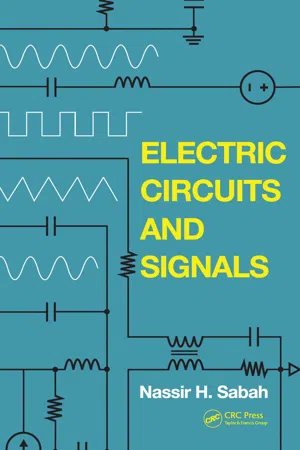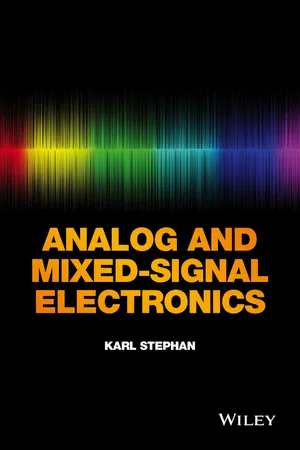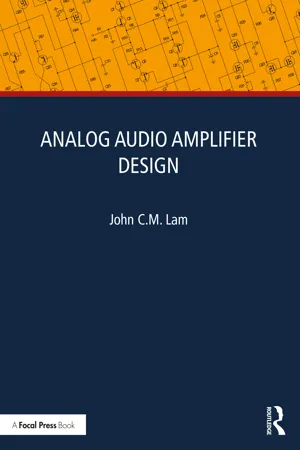Physics
Inverting Amplifier
An inverting amplifier is a type of operational amplifier (op-amp) circuit that produces an output that is the opposite (inverted) polarity of the input signal. It uses negative feedback to stabilize and control the amplification process. The input signal is applied to the inverting input terminal of the op-amp, and the output is taken from the output terminal.
Written by Perlego with AI-assistance
Related key terms
Related key terms
1 of 4
Related key terms
1 of 3
10 Key excerpts on "Inverting Amplifier"
- eBook - ePub
Electronics
from Classical to Quantum
- Michael Olorunfunmi Kolawole(Author)
- 2020(Publication Date)
- CRC Press(Publisher)
4 Operational AmplifiersAs systems architectures evolve toward more complex hierarchical networks, requiring higher-performance body electronics modules and integrated circuits (ICs) to support gateway functions, as well as higher functional integration and centralized services, there is a need to explain the component parts from basic principles to empower future engineers and designers knowing and modifying the systems components as they see fit. This approach will enable the designers and engineers to migrate to higher levels of integration where essentially each electronic module connects well with the preferred system architecture. As a result, this chapter deals with the basic principles of core electronic devices starting from basic electronic operational amplifier (op-amp) characteristics and applications, including simple comparators, multivibrators, and oscillators.4.1 Basic Amplifier Definitions
An electronic amplifier is a device that responds to a small input -signal (voltage, current, or power) and delivers a larger output signal that contains the essential waveform features of the input signal. This process is technically amplification. A signal is any time-varying, or spatial-varying, quantity. The amplification of weak signals into stronger signals is of fundamental importance in almost any electronic system.The principal use of amplifiers is in the measurement process. In computer systems, for example, amplifier circuits are packaged as ICs (or chips ), performing complex tasks including mathematical operations (addition, subtraction, multiplication, integration—calculating the areas under signals, and differentiation—calculating the slopes of signals). In communication systems, for example, it may be advantageous to replace a repeater unit in an optical fiber link by a direct amplification unit, or an amplifier unit could be used in a predetection capacity at the receiver. In power and control systems, amplifiers are used as a basic building block for phase shifting, filtering and signal conditioning, multiplexing, feedback operation, to name a few applications. Technically, amplifiers that perform this kind of operations are called operational amplifiers (op-amps - eBook - ePub
Learn Audio Electronics with Arduino
Practical Audio Circuits with Arduino Control
- Charlie Cullen(Author)
- 2020(Publication Date)
- Focal Press(Publisher)
OUT is close to the entire amplifier voltage signal.The main function of an amplifier is to increase (or perhaps reduce) an input signal for output, and so the gain of the amplifier is its most important practical characteristic. The open-loop gain of an operational amplifier is defined as the uncontrolled (i.e. maximum) possible gain value, which in theory should be infinite – it should ideally be able to increase an input signal by any scaling factor required. In practice, many operational amplifiers will have an actual open-loop gain characteristic that is in the tens or even hundreds of thousands – still far too high for real amplification systems. As with the transistor amplifier in the previous section, some form of negative feedback is therefore needed to bring the gain of an operational amplifier down to a stable and manageable level (Figure 7.37 ).Figure 7.37 Negative feedback amplification example.In the diagram, the microphone signal is connected to the non-inverting input of an operational amplifier which will amplify this signal to drive a loudspeaker as a load (and hence emit sound). The open-loop gain of the operational amplifier would overload the speaker, so a volume control (i.e. potentiometer) is used to feed back some of the output signal to the inverting terminal of the amplifier, where it will be subtracted from the input.The system in this diagram uses negative feedback to reduce the input signal being applied to the non-inverting input of the operational amplifier. The feedback signal is taken from the output of the amplifier and connected to the inverting input, and because the inverting terminal is 180° out of phase it is subtracted from the non-inverting signal. In so doing, the signal is reduced by the amount of feedback provided, which is itself controlled by the potentiometer (volume control) that is connected in series with the inverting input. This combined gain characteristic is known as the closed-loop gain of the amplifier, where the open-loop gain (A) is reduced by the feedback gain (B) connected to the other differential input (Figure 7.38 - eBook - ePub
- Nassir H. Sabah(Author)
- 2017(Publication Date)
- CRC Press(Publisher)
Figure 18.1.1 . According to the preceding definition,v o=A v(=v p− v )A vε( 18.1.1 )where A v is the voltage gain of the amplifier. The following should be noted concerning this definition:- Because the output is determined by the difference between the two inputs, the op amp is an example of a differential amplifier.
- The two terminals are designated as noninverting and inverting because v O is of the same polarity as the input v P applied to the noninverting terminal, and is of opposite polarity to the input v N applied to the inverting terminal.
Ideal Operational Amplifier
This is a very useful idealization that can serve as an initial design step and which is commonly invoked to illustrate some important circuit concepts. Many practical op amps approach the ideal in several respects, so the concept is not as far fetched as it may seem.Concept: An ideal op amp has the following properties:- The output is an ideal voltage source of voltage v O = A v (v P – v N ), with A v → ∞.
- Like an ideal voltage source, the amplifier has zero output resistance and can deliver any output voltage or current, at any frequency.
- Both inputs behave as open circuits.
- The amplifier is free from other imperfections that are mentioned below, such as common-mode response, slew rate, noise, and drift.
Noninverting Configuration
Consider an ideal op amp connected as shown in Figure 18.1.2 . It is desired to derive the relation between the output voltage v O and the input voltage v I . Recall that v O = A v (v P – v N ), with A v → ∞. Although the op amp is ideal, it is useful to consider A v as finite, then let A v → ∞. From Figure 18.1.2 , v I = v P - Felix Alberto Farret, Marcelo Godoy Simões, Danilo Iglesias Brandão(Authors)
- 2017(Publication Date)
- CRC Press(Publisher)
1 Computer Interface and Instrumentation Electronics1.1Introduction
This chapter is based on the assumption that the reader is familiar with basic electronics and understanding of analog circuit–based amplifiers. However, even if this is the first time for anyone with regards to this topic, the authors believe that the following sections show how electronics support and are key in the signal conditioning instrumentation design.In order to start, we can note that electronic amplifiers are used mostly to increase or change the electrical properties of measured signals (voltage, current, impedance, or power). Such signals would hardly be useful to drive functions such as displays, signal processing blocks, or electric drives, and they must be processed by some kind of controller (analog or digital). Specific features such as differential input, feedback, and cancellation of common errors in signal acquisition will make such electronic amplifiers a more suitable device in interfacing electronic circuits or processes, monitored by microcontrollers, or microprocessors or computers. This chapter shows that the differential amplifier is an important system for distortion cancellation of electromagnetic common-mode noises induced in conductors and instrument signal cables, typical of industrial environments [1 ,2 ,3 ].In order to better understand the nonideal behavior of an instrumentation amplifier, this chapter describes the most relevant aspects of basic electronics in applications that would affect from their operational qualities.1.1.1Operational Amplifiers
An operational amplifier is typically available and ready for use, but it is important to understand its constraints and limitations in the operation. The current technology of operational amplifiers makes simpler the design trade-offs such as gain variations by temperature and humidity, avoiding considerations of aging of components, radiation effects, and differences between the discrete components that comprise the system.- eBook - ePub
- Glen Ballou(Author)
- 2015(Publication Date)
- Routledge(Publisher)
5 They are virtually all implemented conveniently in integrated circuits. They come in many different varieties to suit different applications, but the operating and application principles are generally the same for all of them.With a few exceptions, operational amplifiers operate in the small-signal domain, where signal voltages are often less than about 10Vrms. Indeed, many operational amplifiers are operated from ±15V power supplies.24.5.1 The Ideal Op-amp
The ideal op-amp has differential inputs and infinite gain, with no input dc offset voltage and no input bias current. It may be characterized by finite bandwidth, however. This is the parameter referred to as gain-band-width product. It is the frequency where the voltage gain of the op-amp falls to unity, usually at a rate of 6dB per octave. Most real op-amps have very high gain at dc and low frequencies, often on the order of 120dB or more. A typical modern op-amp designed for audio may have a gain-bandwidth product of about 10MHz. This means that the op-amp open-loop gain at 1kHz will be about 10,000, or 80dB (10MHz divided by 1 kHz).24.5.2 Inverting Amplifiers and the Virtual Ground
Consider the simple op-amp inverter in Fig. 24-20 . Assume its open-loop gain is 80dB at dc (it is actually much more). When the op-amp described above is delivering +1V at its output, the signal voltage at the inverting input must be only −0.1 mV, since the positive input is connected to ground. This number is so small and close to ground that we refer to the inverting input node of the op-amp in such a feedback arrangement as a “virtual ground”. The currents in R1 and R2 must be virtually identical. It is then easy to see that a −1 V input is required to produce the +1 V output.Figure 24-20 A unity-gain inverterIn essence, the negative feedback forces these relationships to hold. In practice, the voltage across R1 will be only 999.9mV as a result of the 0.1 mV that actually exists at the inverting input of the op-amp. This means that the gain is ever so slightly less than unity, as expected in a negative feedback system with less than infinite loop gain. Notice that, for the feedback loop gain, the combination of R1 and R2 forms a 6dB attenuator. The loop gain in this arrangement is thus 74dB, corresponding to a ratio of 5000. The closed-loop bandwidth will be on the order of 5 MHz, since the loop gain has been divided by 2 by the combination of R1 and R2 - eBook - ePub
Introduction to Energy, Renewable Energy and Electrical Engineering
Essentials for Engineering Science (STEM) Professionals and Students
- Ewald F. Fuchs, Heidi A. Fuchs(Authors)
- 2020(Publication Date)
- Wiley(Publisher)
8 Operational Amplifiers8.1 Introduction
The operational (OP) amplifier is a basic building block for the design of analog electronic systems such as feedback control circuits [1 ], where the angular velocity ω m (t), angular position θ m (t) = ∫ω m (t)dt, current i(t), and torque T(t) must be controlled. An OP amplifier with no external circuitry is a voltage amplifier with a very high open‐loop voltage gain that ideally approaches infinity A v → ∞, as shown in a symbolic manner in Figure 8.1 . Note that input/output voltages can be either time varying or time independent, and they can be either periodic or nonperiodic.OP amplifiers are integrated circuits (IC), which can be purchased off the shelf, and they contain transistors, diodes, resistors, and capacitors all fabricated on a single silicon chip. Inductors are bulky and are mostly avoided in OP amplifier designs. The analog electronic circuit of Figure 8.1 has two inputs: a negative (v − ) and a positive (v + ) input supplied by the voltages v in1 and v in2 , respectively, whose difference in voltage (v in2 − v in1 ) produces an output signal voltage v out that is a replica of the input voltage difference. The two‐input voltage approach is useful because stray signals/electric noise that appear on both inputs are cancelled, and only the voltage difference is amplified. An OP amplifier is also called a differential amplifier because the output voltage is a voltage that is A v times the voltage difference between the two inputs. During the past half century, OP amplifiers have been refined and improved to the extent that they have nearly ideal properties, and therefore we discuss in this textbook the performance of ideal OP amplifiers only. The understanding of nonideal properties of OP amplifiers requires detailed electronic knowledge [2 - eBook - ePub
- Karl Stephan(Author)
- 2015(Publication Date)
- Wiley(Publisher)
5 OP AMP CIRCUITS IN ANALOG ELECTRONICS 5.1 INTRODUCTION An operational amplifier (hereafter “op amp”) is a specially designed amplifier that can be used in a huge number of analog-circuit applications. It is fair to say that almost anything you can do in analog electronics without op amps is easier, smaller, and better performing if done with op amps. And some things are almost impossible to do without op amps or their functional equivalents. Why are op amps so important to analog electronics (and mixed-signal electronics as well)? Because they make the use of negative feedback easy and straightforward and confer its blessings on any circuit where they are used. To understand the importance of negative feedback for op amps, a little history is helpful. Although the concept of negative feedback was studied by nineteenth-century physicists such as James Clerk Maxwell, negative feedback as used in electronics was developed by a Bell Labs engineer named Harold S. Black, who in the 1920s was struggling with the problem of how to improve the repeater amplifiers the Bell System was trying to use to span the US continent with long-distance telephone lines. Nonlinearities were a significant problem, because in traveling through repeaters spaced every 25 miles or so along a cable, signals encountered distortion that was tolerable in one amplifier, but which accumulated to unacceptable levels as the signals passed through dozens of amplifiers in cascade. Black realized that if he built an amplifier with much more gain than necessary and then reduced the gain by “feeding back” a portion of its output signal to the input with the proper polarity, nonlinear distortion would decrease roughly in proportion to the amount of sacrificed gain. Gain, while not free, was relatively easy to obtain simply by cascading stages, and it turned out to be a good engineering trade-off to sacrifice inexpensive gain for the much-sought-after reduction in distortion - eBook - ePub
- David Crecraft(Author)
- 2018(Publication Date)
- CRC Press(Publisher)
1. Draw an a.c. equivalent for an op amp, using appropriate values for the equivalent circuit parameters taken from a manufacturer’s data sheet. 2. Explain the principle of negative feedback. 3. Describe the characteristics of a frequency-compensated amplifier. 4. Derive the standard form of the feedback equation for a voltage-derived series feedback amplifier. Voltage amplifier 5. Describe the conditions which can give rise to instability in feedback amplifiers. 6. Analyse the effects of feedback on the amplifier frequency response and equivalent circuit parameters. 7. Using appropriate simplifying assumptions, explain and analyse the operation of some practical feedback circuits. 8. Calculate the output offset voltage of a differential amplifier, given its bias currents, input offset current and input offset voltage. 9. Calculate the output noise voltage of an amplifier, given the power density spectra of its equivalent input noise sources. 4.1 WHAT ARE AMPLIFIERS?The purpose of an amplifier is to increase the power in a signal without distorting it. This process is called amplification. For example, amplifiers are used to increase the power in the signal from a microphone so that it can drive a loudspeaker, or to amplify the control signals produced by the pilot of an aircraft so that they will move the flaps on the wings and other control devices. The extra power must come from a power supply. In the case of an electronic amplifier, the power supply is usually a d.c. voltage power supply (which gets its power from the a.c. supply mains) or a battery.The input signal causes the amplifier to control the flow of current from this voltage supply to the load. Thus more power may be delivered to the load than is taken from the input signal source. In practice, amplification usually means increasing the voltage amplitude of the signal into a given load. The opposite of amplification is called attenuation - eBook - ePub
- Clive Maxfield, John Bird, Tim Williams, Walt Kester, Dan Bensky(Authors)
- 2011(Publication Date)
- Newnes(Publisher)
Figure 11.11 . This circuit is essentially an Inverting Amplifier in which 100% of the output is fed back to the input. The result is an amplifier that has a voltage gain of 1 (i.e., unity), a very high input resistance and a very high output resistance. This stage is often referred to as a buffer and is used for matching a high-impedance circuit to a low-impedance circuit.Figure 11.11 A voltage followerTypical input and output waveforms for a voltage follower are shown in Figure 11.12 . Notice how the input and output waveforms are both in-phase (they rise and fall together) and that they are identical in amplitude.Figure 11.12 Typical input and output waveforms for a voltage follower11.9.2 Differentiators
A differentiator using an operational amplifier is shown in Figure 11.13 . A differentiator produces an output voltage that is equivalent to the rate of change of its input. This may sound a little complex but it simply means that, if the input voltage remains constant (i.e., if it isn’t changing) the output also remains constant. The faster the input voltage changes the greater will the output be. In mathematics this is equivalent to the differential function.Figure 11.13 A differentiatorTypical input and output waveforms for a differentiator are shown in Figure 11.14 . Notice how the square wave input is converted to a train of short duration pulses at the output. Note also that the output waveform is inverted because the signal has been applied to the inverting input of the operational amplifier.Figure 11.14 Typical input and output waveforms for a differentiator11.9.3 Integrators
An integrator using an operational amplifier is shown in Figure 11.15 - eBook - ePub
- John C.M. Lam(Author)
- 2024(Publication Date)
- Focal Press(Publisher)
4Operational amplifiersDOI: 10.4324/9781003369462-44.1 Introduction
Figure 4.1 shows a diagram of an operational amplifier, which is often called an op-amp. An opamp has two inputs (inverted and non-inverted), one output, and dual power supply terminals. Some op-amps also offer two more terminals for connecting a trimmer to reduce dc offset voltage. Op-amp is a versatile electronic device that is found in almost every electronic application. A good understanding of op-amp and its applications is essential to perform the design work for audio and linear application.Diagram of an operational amplifier (op-amp)Figure4.1An ideal op-amp has the following properties [1 –3 ]:- infinite differential voltage gain;
- infinite input impedance;
- zero output impedance;
- zero input offset voltage;
- zero input bias current.
Therefore, the differential inputs of an ideal op-amp must be zero, i.e., V+ ‒ V- = 0, and the input current is also zero, i.e., I+ = 0, I- = 0. We can easily see why these must be true. If Av denotes the differential voltage gain of the op-amp, the output is given asVout =(V+-V-)AvFrom a mathematical point of view, if the differential voltage gain Av approaches infinite, the output will also approach infinite. In order to confine the output to a finite value for practical use, the term (V+ ‒ V-) must be zero. In other words, the non-inverted input and inverted input must be equal at all times, V+ = V-. On the other hand, since the input impedance is infinite, it can be easily understood that the input current must be zero, I+ = 0 and I- = 0. These properties lead to the so-called golden rules for op-amp application analysis:- non-inverted and inverted inputs are equal at all times, V+ = V-
- zero input current at all times, I+ = 0 and I- = 0
Even though an ideal op-amp does not exist in real life, the golden rules help tremendously to simplify the op-amp application analysis. After all, the results that are determined by applying the golden rules are sufficiently accurate for almost all applications. In the following, some audio and linear applications using an op-amp are discussed.
Index pages curate the most relevant extracts from our library of academic textbooks. They’ve been created using an in-house natural language model (NLM), each adding context and meaning to key research topics.
Explore more topic indexes
Explore more topic indexes
1 of 6
Explore more topic indexes
1 of 4









